Higher education institutions today are struggling to recruit and enroll students. Several factors are at play, including changing student expectations, increased competition, and fewer potential students due to declining birth rates.
To succeed in this competitive landscape, colleges and universities are trying to find new and innovative ways to reach potential students.
However, today’s students want personalized communication that is relevant to them. The old ways of mass marketing aren’t cutting it anymore.
This article explores how personalization in higher education marketing can transform recruitment outcomes, boost enrollment, and create meaningful connections with prospective students. We’ve also put together a free checklist for you to quickly start planning personalized outreach!
Key Takeaways
The current generation of prospective students needs more from university recruitment teams. Personalization is no longer optional. Students expect tailored, relevant outreach across all stages of their decision-making journey. Institutions that fail to adapt risk losing out to more agile competitors
- Technology makes personalization easier than ever: From AI-driven content generation to CRM-enabled segmentation, institutions now have a wide range of tools to scale personalized communication effectively
- Start early, and stay consistent: Personalization should begin as early as the first website visit or social media interaction and continue through acceptance and enrollment, nurturing the student relationship at every stage
- Challenges are real—but solvable: Whether it’s resource constraints, institutional silos, or privacy concerns, universities can adopt clear strategies to move forward with confidence
- Success depends on data and collaboration: Mapping the student journey and leveraging cross-functional collaboration are critical for creating meaningful student experiences that drive results
Read on to see your university can create an effective outreach plan that is personalized as well as cost-efficient.
Personalization in Higher Education Marketing: Context
Personalization in higher education marketing involves tailoring communication, content, and experiences to individual prospective students. This can be based on their interests, behaviors, demographics, or stage in the student journey.
Unlike one-size-fits-all campaigns, personalization focuses on creating relevant and useful interactions—from personalized emails and dynamic website content to retargeted ads and individualized student portals and more.
Did You Know: 87% of students who received personalized communications said that it was an important factor in their college decision.
Why This Matters
- Improved engagement: Students are more likely to engage with content that resonates with their interests and aspirations
- Increased conversion: Tailored messaging drives higher application and enrollment rates
- Better student experience: Personalization shows prospective students that the institution understands and values their unique goals
Institutions that leverage data analytics to create personalized experiences are seeing higher engagement and conversion rates.
Most importantly, with generative AI tools, personalization is easier to execute than ever before. It is literally table stakes now; universities that don’t adopt this strategy will see themselves left behind by more agile competitors.
What Students Expect Today From Universities
A study by Salesforce found that 69% of students expect their university to understand their unique needs and expectations. Meeting these expectations through personalization builds trust and boosts your institution’s appeal.
Gen Z and younger students are true digital natives who’ve grown up in a world where algorithms curate their social media feeds, streaming services recommend content, and retailers anticipate their shopping preferences.
These experiences have shaped their expectations for college selection.
A 2024 Hanover Research study found that 84% of prospective students are more likely to consider institutions that demonstrate understanding of their specific career goals and academic interests from the first interaction.
Today’s students expect:
- Program recommendations aligned with their academic and career interests
- Communication that acknowledges their demographic characteristics and life circumstances
- Content delivery through their preferred channels
- Timing that matches their decision-making stage
Explore Tip: Explore’s Amplify offering enables universities to engage with qualified international students through different content formats, such as email, platform notifications, banners, surveys, videos, and more. Reach out to learn more.
Personalization Across the Student Journey
Let’s look at how universities can personalize outreach and engagement with students at various touchpoints.
Pre-Inquiry: Attracting Prospective Students
At this stage, personalization in higher education marketing can help an institution stand out from the competition.
Did You Know: Carnegie Mellon University offers personalized viewbooks to prospective students on the university website. Students can choose to see selected content about the university based on their academic interests and facets of college life they are keen to understand.
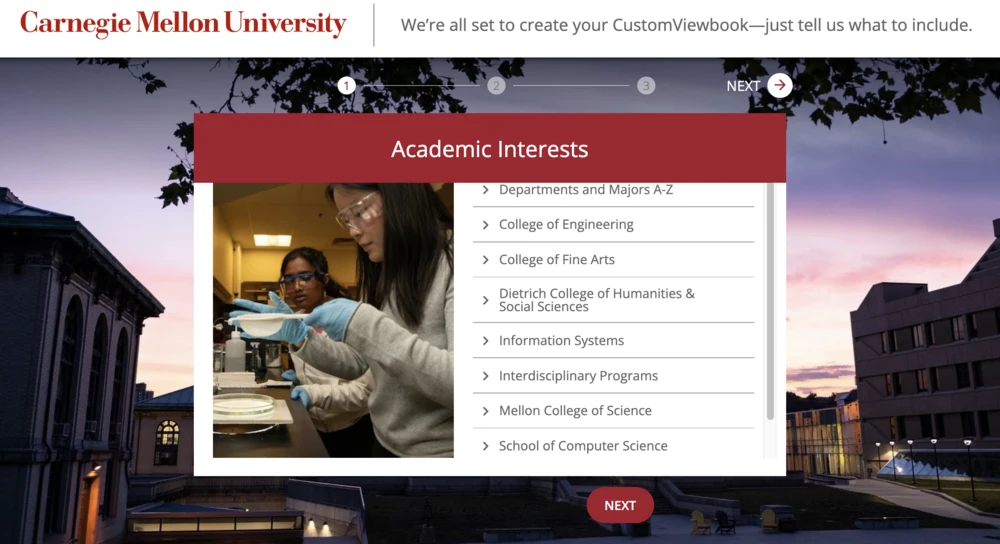
Some possible personalization approaches at this stage include:
- Dynamic website content: Your website is often the first touchpoint for prospective students. Relevant content improves engagement and helps visitors find what they need faster. Display program pages, testimonials, or events based on the visitor’s region or previously viewed pages. For instance, Wilfrid Laurier University’s use of web personalization in higher education marketing improved student engagement and brought in over 2,000 sign-ups to a health sciences program
- Social listening and interaction: Prospective students are highly active on social media channels like Instagram, Snapchat, Facebook, etc., while researching universities. University marketing teams can drive affinity by being responsive to mentions and plugging into conversations online
- Paid social targeting: Compared to generic institutional messaging, program-specific content served to prospective students on social platforms leads to greater engagement
Inquiry to Application: Nurturing Interest Through Personalization
Did You Know: Less than 3% of first-time visitors to a website convert in the same visit. To ensure they return, retargeting is a critical inclusion in your marketing plan.
Once a prospective student has shared information with you, personalization becomes easier. The most commonly used methods in higher education marketing include:
- Retargeting ads: Universities using personalized retargeting ads on search and display see an average 34% increase in application starts compared to standard digital advertising approaches.
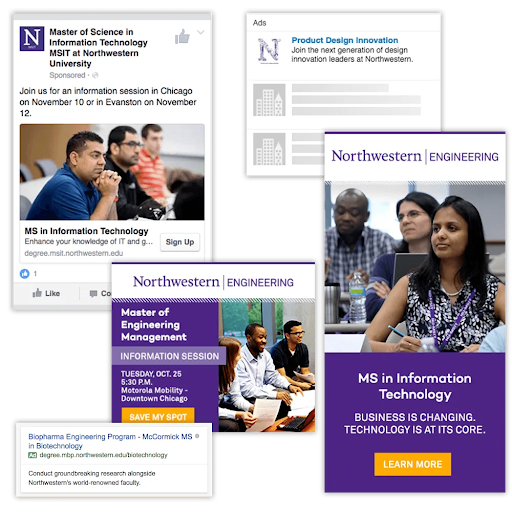
- Behavior-triggered emails: Marketers can set up email sequences based on specific behaviors and website browsing patterns (for example, someone making multiple visits to a specific program page, or attending a college fair). Indiana University increased conversion rates by 7% with a personalized email strategy.
- Academic interest nurturing: Develop distinct communication based on the academic interest areas of your prospective students. Delivering program-specific content, faculty profiles, and student testimonials relevant to each prospect’s interests will help increase qualified applications
Research shows that communication targeting students’ interests has a better chance of being read. They value information about college costs, scholarships, and housing options.
Explore Tip: With Connections by Explore, partner universities can segment student connections by their preferred destination and program, budget, graduation year, and other relevant details.
Acceptance to Enrollment: The Critical Conversion Period
Personalized communication doesn’t just end with application season. It can also be a very meaningful strategy to keep accepted students engaged.
Accepted students will expect personalized updates regarding financial aid, college programs, campus life, orientation, and more.
Did You Know: Personalized promotional mailings have 29 percent higher unique open rates and 41 percent higher unique click rates than nonpersonalized mailings
Georgia State University experimented with a chatbot for student outreach to combat rising summer melt rates. The bot, called Pounce, engaged with accepted students and nudged them through the pre-matriculation activities, tailoring outreach as per each student’s current data.
The activity led to a 3% increase in orientation attendance, a 12% increase in loan acceptance, and a 4% higher enrollment rate for the program.
Many universities today are also using personalized videos to inform and engage accepted students and improve yield.
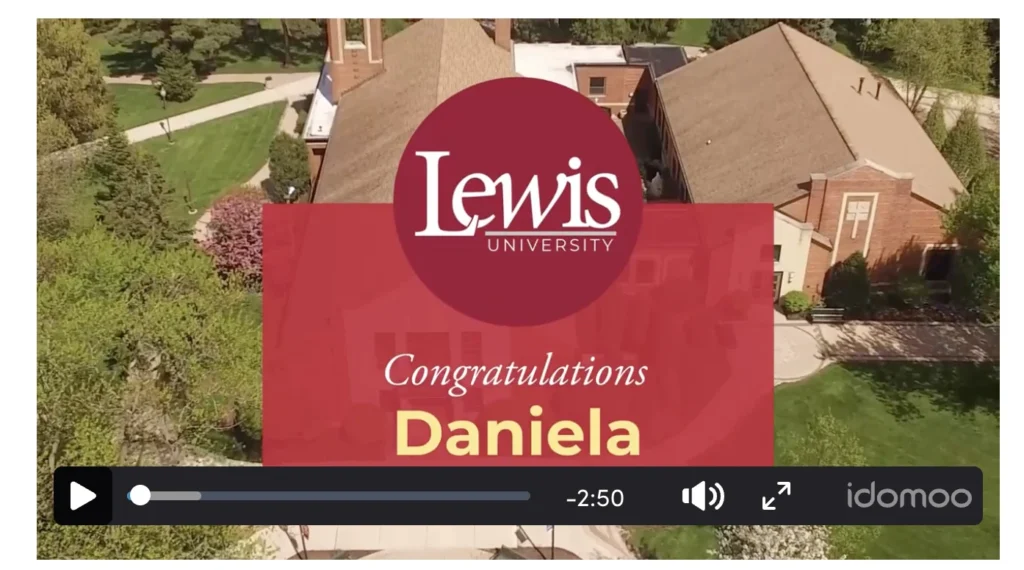
For example, Lewis University sends out visually engaging videos of the campus to accepted students, with customized information about financial aid. These videos, created with over 30 different data points, have an 86% completion rate.
Explore Tip: Experiment with personalized videos in your outreach. Tools like HeyGen and Synthesia let you create AI avatars of recruiters in seconds and easily scale your customized outreach.
Common Challenges in Personalization and How to Overcome Them
While personalization in higher education marketing is effective in improving engagement, you could face a few possible challenges.
Resource Constraints
Shrinking budgets are everywhere. However, this shouldn’t discourage you from testing out some personalization strategies. Here are some tips:
- Start small, with your most important segments or programs. This will help you prove ROI with a limited budget
- Leverage templates and generative AI to create reusable content blocks, which will keep content creation costs down
- Implement new technologies gradually, to distribute the cost impact over a broader period
- Unable to invest in a CRM just yet, or just don’t have the bandwidth? Tie up with a partner who can do the necessary data analysis and segmentation for you
Explore Tip: With lead quality identified in Connections, universities can prioritize their outreach efforts to maximize ROI. Assign hot, warm, or cold tags to leads—then tailor your approach for each! Slate integration lets you track student enrollment outcomes, providing real-time insights into your lead generation efforts
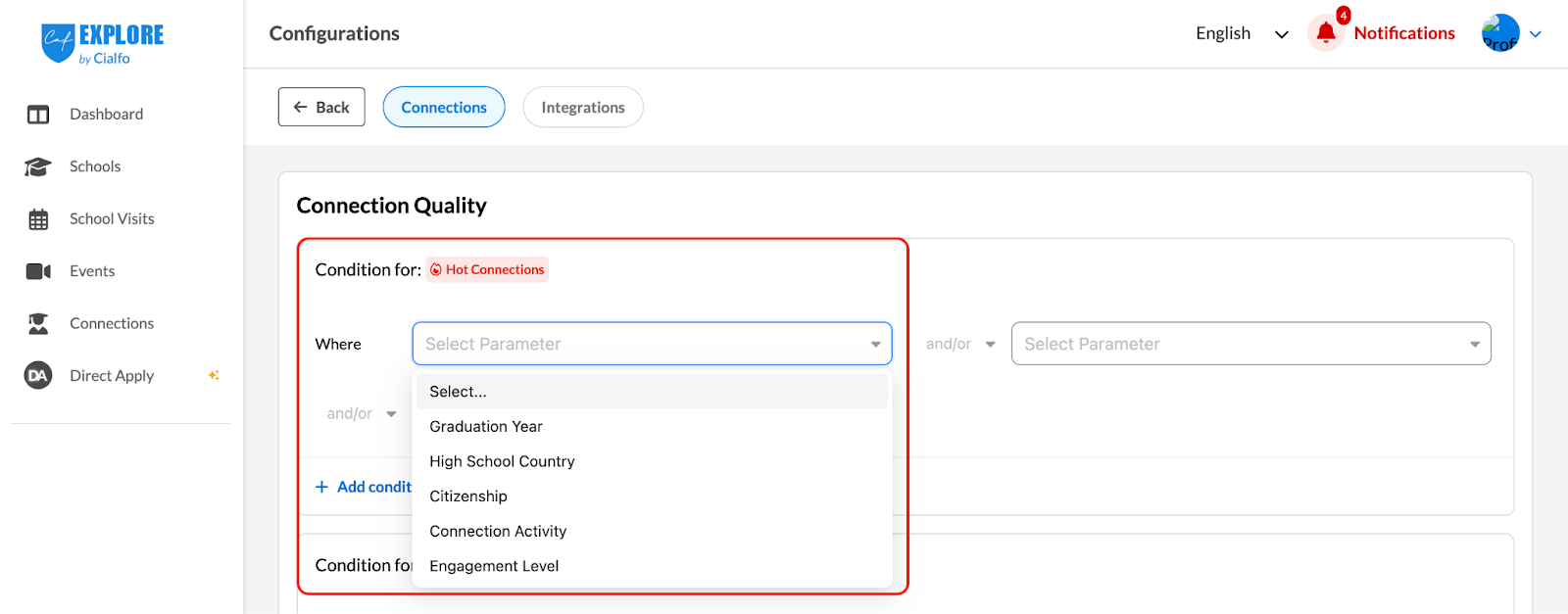
Institutional Silos
For effective personalization, you will require multiple teams and departments to work collaboratively.
- Create a common data governance framework across all relevant departments to ensure a unified view of prospective and current students
- Build cross-functional teams to create personalization processes and content. This joint effort incorporates inputs from various perspectives and brings production time down as well
- Develop a shared understanding of success metrics and KPIs for the initiative, to create accountability and demonstrate the value of the effort
Privacy Concerns and Compliance
Balancing personalization with privacy requires careful consideration.
- Develop region-specific personalization approaches to comply with varying privacy regulations (GDPR, CCPA, etc.)
- Maintain transparency about data policies, with clear opt-in processes. When your audience is aware of what their information will be used for, the majority will be happy to share details
Best Practices for Implementing Personalization
If you are considering upgrading your student outreach program into a more personalized one, here are things to consider:
- Start with journey mapping: Develop personas for different student types (e.g., international undergrad, state resident, transfer student, etc.) and map their journey from awareness to enrollment. Use this to tailor touchpoints and add elements of personalization.
- Assess current capabilities: Evaluate whether you currently have the required content, technologies, and human resources to execute the plan. Identify tool gaps and hiring or training needs. You may also decide to outsource part of the activity to a partner with the necessary expertise.
- Use data responsibly: Leverage data on students’ behavior, demographics, and engagement to provide them with valuable personalized interactions. However, ensure that each personalized interaction offers genuine value. Be upfront about how data is collected and its purpose. Also, get explicit consent for all communication, and let students manage their communication preferences.
- Test, measure, and iterate: Try different types of personalized content and campaigns to learn what works best for your audience. Regularly evaluate performance metrics like open rates and conversions, and use insights to improve your personalization strategy.
Explore Tip: Universities can view the engagement level of each student connection in the Explore platform. Plus, AI-generated ‘next step’ recommendations help marketing teams plan more segmented outreach campaigns.
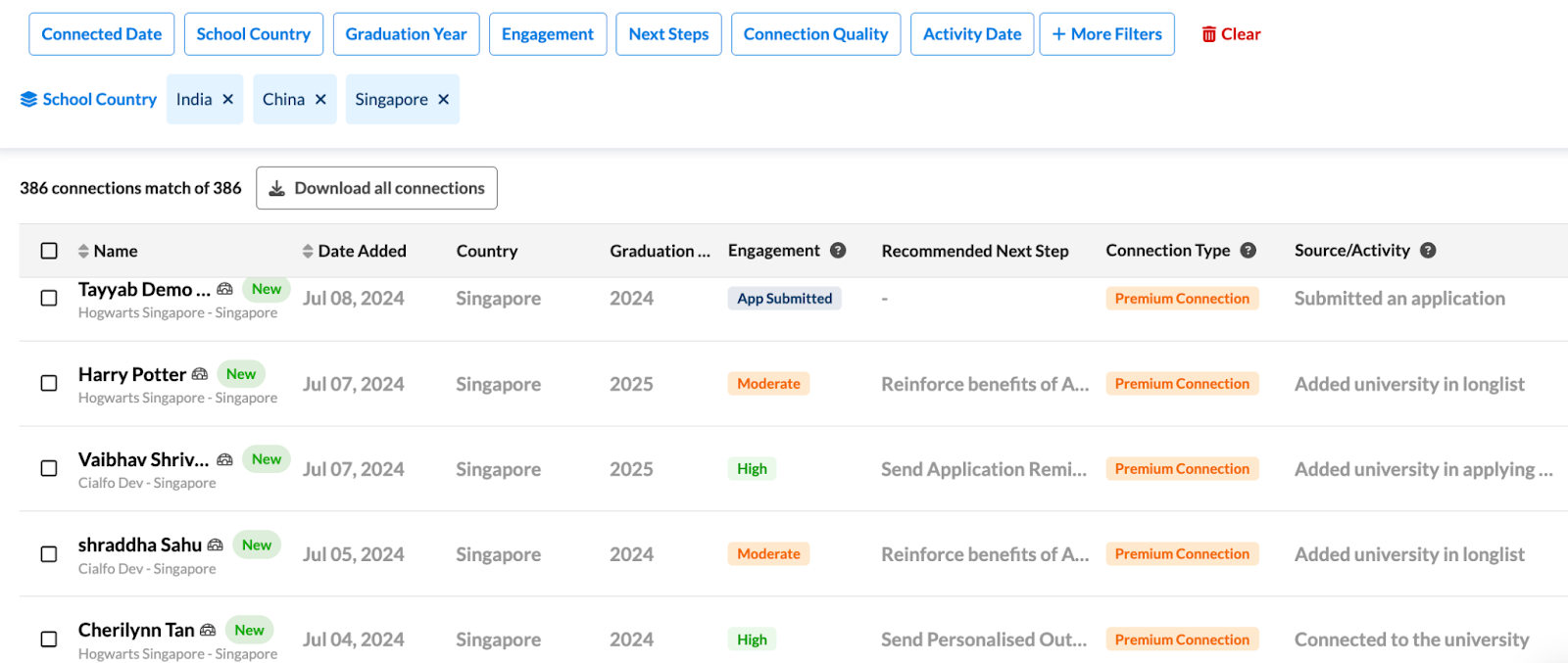
Customize Your Student Outreach at Scale With Explore
Personalization in higher education marketing is changing the game. If done right, it helps institutions cut through the noise and engage students meaningfully. The right personalization strategy improves recruitment outcomes and student satisfaction.
Start small, use the right tools, build a culture of experimentation, and keep the student needs at the heart of your strategy. That’s the path to more effective student marketing.
Get your free printable checklist for planning your next personalized student outreach campaign.
Explore can help you personalize your student outreach across multiple geographies. Institutions like Imperial College, Ithaca College, and Brunel University are already benefiting from the improved data flow and targeting.
To know how to get the Explore advantage for your university, get in touch!


